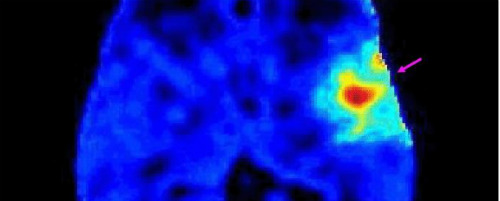A new molecular-level imaging technology from Israel can detect diseases in the cells themselves, and target cancer cells directly, without harming healthy ones.

The majority of diseases begin the same way – with the process of cell death, otherwise known as apoptosis. While most imaging techniques seek to reveal abnormalities in the shape and appearance of the body’s organs, Israel’s Aposense, a clinical stage drug development company, has developed a molecular imaging technology to detect apoptosis in the cells themselves, at the earliest phase of a disease.
This technology has multiple uses. It can detect diseases before the symptoms manifest themselves; track the day-to-day progress of cancer treatment; and significantly, it can target and treat cancer cells via injection, without harming healthy cells and obviating the need for invasive procedures.
Founded originally by neurologist Ilan Ziv in 1997 and chaired today by Eli Horovitz – the former CEO of Teva Pharmaceuticals, Aposense takes a two pronged approach, says CEO Yoram Asheri – diagnostic and therapeutic platforms.
“The technology is manifest in a family of small molecules, which when injected into the body can identify cells in apoptosis,” Asheri tells ISRAEL21c. “These molecules carry a load or compound with which to identify the cells with a PET scan. The other application area consists of a load that is capable of therapeutic function, but localized in these cells.”
Identifying dying cells
On the diagnostic side, Aposense technology is broadly applicable to many diseases, whether they are inflammatory, cardiovascular, neurodegenerative, infectious or genetic. “If tissue is lost or damaged, apoptosis is probably the culprit,” says Asheri.
In the treatment of cancer, where the death of tumor cells is the desired result, the Aposense diagnostic technology can provide clinicians with quick and early treatment results. Too often results are only available after a period of months, by which time the knowledge that a treatment is not successful may arrive too late for the patient’s recovery.
Every individual responds differently to treatment, and it’s the oncologist’s challenge to find the optimal combination for each patient. This challenge is exacerbated by the extended waiting period for treatment results, Asheri explains.
“One of the biggest problems in oncology is that it takes months to identify a response, to see if the treatment is working,” Asheri tells ISRAEL21c. “Clinicians now rely on anatomical imaging to see the size of a tumor. In contrast, molecular imaging shows the response very early – within a day or week – far beyond any means of diagnosis that are in use today.
“By allowing clinicians to know early if a treatment is working, we are opening a new paradigm of tailoring treatments to the patients, within the framework of personalized medicine,” he explains.
In several clinical trials with patients being treated for brain tumors at the Rabin Medical Center in Petah Tikva, Aposense diagnostic technology predicted the shrinkage of tumors with 90 percent accuracy, by comparing initial predictions based on molecular imaging with the MRI results two months later.

Targeting cancer cells directly
An additional benefit of molecular imaging diagnostics is its non-invasive approach, in contrast to the current means of diagnosis which involve taking tissue samples.
Aposense’s latest move, in collaboration with Teva, is to treat cancer with the same technology, by loading the molecules injected into the cancerous cells with a therapeutic compound. If successful, this approach would both increase the effectiveness of cancer treatment, while dramatically reducing the dosage and side effects of chemotherapy.
With the aim of beginning clinical trials in 12 to 18 months, so far Aposense has seen significant success with this new form of targeted cancer treatment.
“We take compounds which are currently not targeted, and make them a targeted drug with our probes,” explains Asheri. Relating specifically to chemotherapy, he says, “We know the drug works – the limitation is that it’s nonspecific, and has significant side effects. By linking it with our probe we can turn it into a specifically targeted treatment, and achieve a superior result using 20% of the current dose.”
In June, Petah-Tikva based Aposense completed an IPO on the Tel Aviv Stock Exchange with resounding success. The company, which has a staff of just 25, raised a gross $25 m. at a company value of about $238 m., after money.
It’s no surprise to investors. Depending on market penetration, Asheri concludes, “A technology that can do as we describe – identify very early in treatment responders or non-responders – has a potential worldwide market of about $3 billion.”












